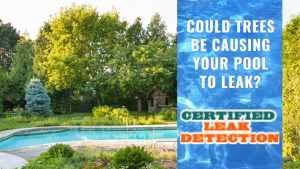
In Central Florida, a swimming pool is your slice of paradise. This, of course, includes the backyard, which homeowners love to landscape accordingly. Creating an inviting, functional outdoor recreation area is a point of pride. But could the trees that provide shade and beauty pose a hazard to your swimming pool as they grow and their root systems expand? That depends upon several factors. So if you already have trees near your pool, read on, then take a close look to determine if trouble is on the horizon. And if you’re planning to add trees to your pool landscaping, here’s what you need to know to prevent problems!
Damage caused by tree roots
It is possible for tree roots to damage an in-ground swimming pool, depending on the type of pool. The good people at PoolMax explain the circumstances as follows:
“With regards to root growth, concrete pools and fiberglass pools will not be affected if your tree roots grow substantially in the future. The roots will grow around the pool structure and conform to it. They will not be strong enough to shift the pool or poke through it. With that in mind, pools with vinyl siding could be at risk of damage from root growth. If you are planning to get a vinyl pool, you will want to be very careful about where you position it.”
For yards without a screened pool enclosure, the rule of thumb is to plant at least six feet from the pool – with 15 feet away being preferable. One mistake that many homeowners make is not considering a tree’s maximum growth potential. That little tree you bring home in a container today may eventually command a good area of yard, with leafy branches above and a potentially invasive root system below.
And while we’re talking about potential damage from roots, be very aware of the location of your underground water and plumbing pipes when planting. Or blog post – “How to Know If Your Underground Pipes Are Leaking” – covers this situation in greater detail.
For those who have a screen enclosure for their pool and patio, the close proximity of tree roots to the pool isn’t an issue, as most tall trees with spreading root systems tend to be well outside of the enclosure. If anything, the patio pavers may be more at risk.
If you’re planning landscaping for a new pool with a screened enclosure, do some online research on the best species for this particular environment. Your pool contractor may be able to provide advice, as well as employees in the garden department of home improvement centers and independently owned plant nurseries. In addition to choosing species that don’t have a spreading root system, be sure you don’t install a tree that has the potential to grow taller than the roof of the enclosure.
Are all trees bad for pools?
As previously mentioned, following simple distance guidelines for planting in a yard with a swimming pool should prevent root invasion. Again, the type of pool construction most susceptible is vinyl.
That being said, oak trees are highly desirable in Central Florida, but have extensive root structure – which could eventually cause problems for underground pipes. Palms, evergreens and magnolia trees have a shallower root system, which makes them appropriate for planting just outside the recommended six-foot minimum distance from the pool’s edge.
If a tree is causing damage – or has the potential do so in the future – removing it is necessary. This is a job for a professional tree service, not a DIY project. Most homeowners don’t have the equipment and personal protective clothing and gear to do this safely and efficiently – not to mention the physical strength. It isn’t worth cutting corners and risking serious injury (or worse) to save a few dollars.
The tree is cut, now what?
Should you have to remove a tree, also have the tree service remove the stump. This isn’t a DIY job, either – leave it to the pros! If not removed, it can cause the problems covered in this article by swimming pool and landscaping contractor Woodfield Outdoors
“If you cut down a tree that is in the footprint of your pool or in the close surrounding area, you need to remove the stump. If you don’t, the stump will eventually rot and decompose, creating instability in the soil under or around your pool. This in turn can create problems for your pool, including shifting or cracking.”
The take-home message
Spending more time at home these days can make “red flags” that could indicate a leak in your swimming pool, spa, fountain, underground pipes or slab more obvious. If you notice evidence of a leak, the longer it goes unrepaired, the worse it will become, resulting in greater damage and repair expense.
Should you suspect trouble, Certified Leak Detection is experienced in leak detection and repair for Orlando, Longwood, Lake Mary, Sanford, Kissimmee, Clermont and Winter Springs. Trusted by homeowners and business owners throughout Central Florida, our team is ready to answer your call. Contact us for quick, reliable service.

